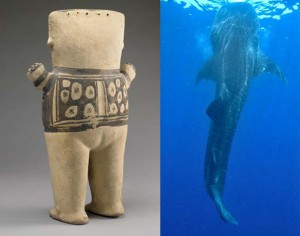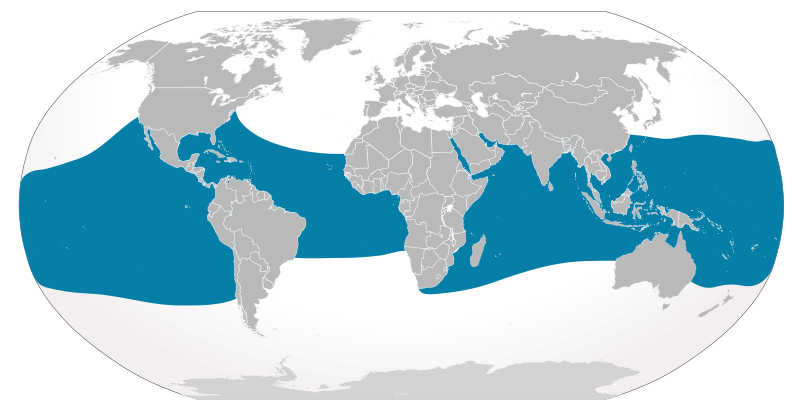The whale shark (Rhincodon typus) is by far the world’s largest fish and cold-blooded mammal, the largest recorded measuring 40’7.” Females are larger than males, in fact, which may be a factor in why a female shaman might have claimed an all-the-more impressive whale shark alter ego. They swim the waters of the Pacific along the western coast of South America. Although they inhabit the open ocean, whale sharks do come close to shore and even can enter estuaries and the mouths of rivers as far as the water remains salty. Therefore the Chancay people almost certainly would have seen them, especially from boats, the angle of the photograph above.
One would not tend to forget the sight of such a giant spotted shark with a nearly five-foot wide mouth. Inside that human-length mouth lie several thousand tiny pointed teeth arrayed in eleven to twelve rows. Although they do not use them to chew, but rather filter zooplankton through gill slits, there are often fish swimming in front of and just inside the mouth, which could have suggested to the ancients that they ate them with their teeth. Though the teeth are not necessarily easy to see, as the sharks swim they often drag their enormous open maw half out of the water, presenting further opportunities to glimpse the teeth. The wide painted series of small jagged teeth along the jaw line of the effigy correspond well to those of the whale.

Female Whale Shark-Shaman South America, Central Andes, Central Coast. Chancay. Late Intermediate Period, 1200-1450 AD. Ceramic. 1988.12.12. Gift of William C. and Carol W. Thibadeau. Photo by Bruce M. White, 2008. Whale Shark viewed from above. Photo by Marjorie Awai.
In addition, the animal often positions itself vertically in the water, mouth up to the water surface. Not only does this also allow access to the mouth, it can make the whale shark seem like a fish that “stands” like a person. In general, the vertical position facilitates the creation of a visual analogy between the shark and the shaman. Usually fish are horizontal animals but in this case a standing figure can encapsulate one. In this position, the pectoral fins and the split tail also are positioned much like the arms and legs of a person, and suggest that the effigy’s wonderfully knobby knees and anklebones may reference the various fins as well.
Finally, a whale shark’s bulging eyes are round, with a dark, centrally placed circular pupil (although foreshortening can make them appear oval as they do on the left). Significantly, the animal “does not have any eyelids, but is able to ‘close’ its eyes by rotating them and sucking them back into its head.” There is also a deep circular hole –called a spiracle, which is actually a vestigial gill slit– about a foot behind each eye. This feature would easily suggest to an ancient viewer a second set of eyes or, by human analogy, the opening of an ear. These sensory organ characteristics would have had strong shamanic resonance, as entranced shamans’ eyes bulge and may well roll back in their heads, plus they both see and hear in different and enhanced ways.


